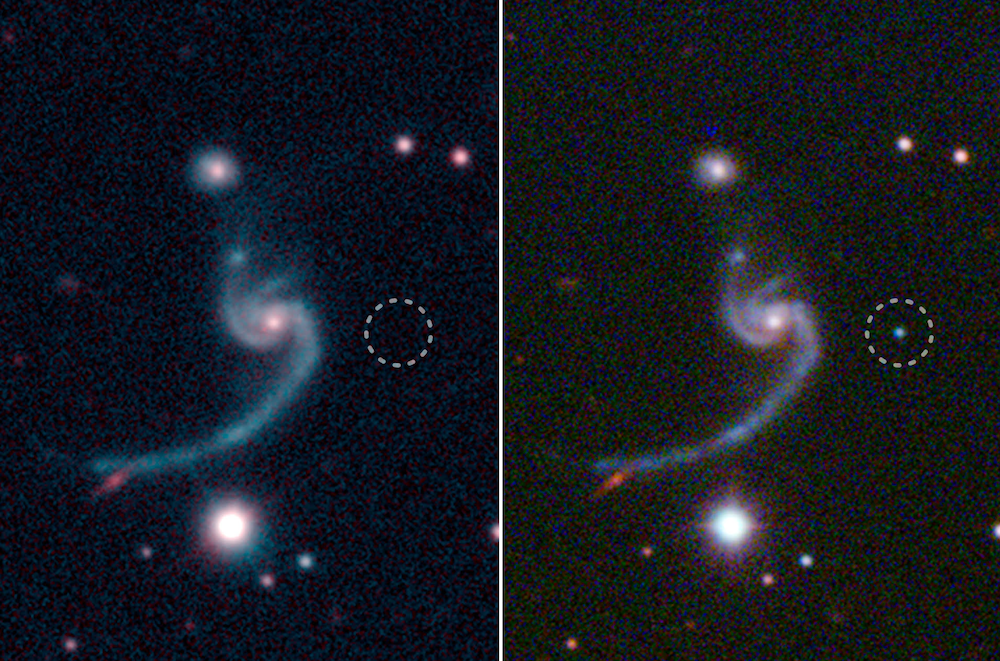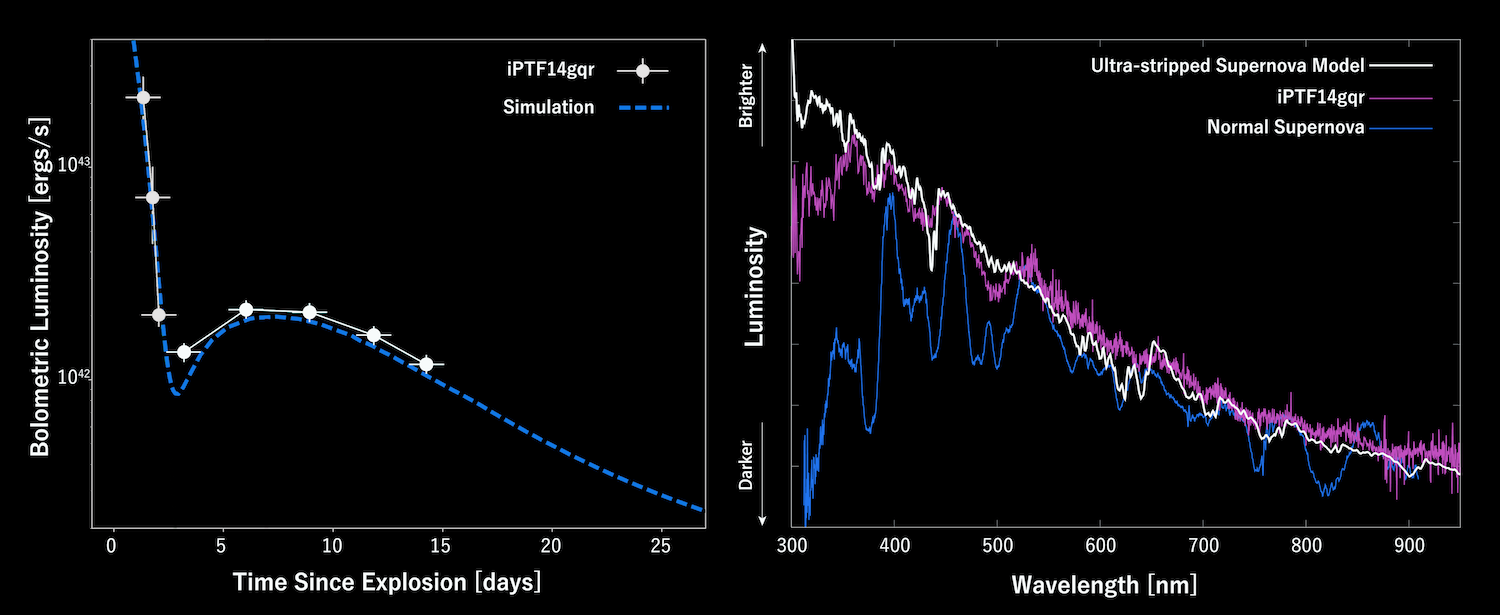Press Release | Division of Theoretical Astronomy, National Astronomical Observatory of Japan
Little Supernova is Big Discovery: the Origin of Binary Neutron Stars
2018.10.12 Released
An international research team discovered the first recorded "ultra-stripped supernova," a rare, faint type of supernova that is believed to play a role in the formation of binary neutron star systems. These findings will advance our understanding of a wide variety of topics ranging from gravitational waves to the origin of precious metals like gold and platinum.

|
Fig 1:
Left: Red and green composite image from the Sloan Digital Sky Survey (SDSS) taken before supernova iPTF14gqr. Right: Red/green/blue composite image from the Palomar 60-inch telescope taken on October 19, 2014, during supernova iPTF14gqr. The circles indicate the position of the supernova.
Credit: SDSS/Caltech
[Small size, PNG (1.7 MB)] [Large size, PNG (5.1 MB)] |
A collision between two neutron stars produces a variety of heavy elements, including precious metals. Such a collision also produces electromagnetic waves and gravitational waves like those observed in August 2017. Although these collisions have been observed, it was unknown how two neutron stars could form close enough together to eventually spiral down into each other and collide.
A neutron star is a dense, compact object left behind when a massive star sheds most of its outer mass in a supernova explosion. Thus a neutron star binary system must have started out as a binary system of two massive stars. But this posed a problem because it was believed the second explosion would expel most of the remaining mass and make the system unstable rather than forming a neutron star binary system.
A research team including Takashi Moriya at the National Astronomical Observatory of Japan (NAOJ) proposed a new formation hypothesis where the gravitational force of the neutron star formed during the first supernova strips most of the outer layer of the remaining star. When this "ultra-stripped" star then explodes, the supernova has much less ejecta and the system can remain stable. The team named this second type of supernova “ultra-stripped supernovae.”
Moriya simulated the light from ultra-stripped supernovae. His simulations predicted the explosion energy would be smaller than normal supernovae and that the brightness would peak at 5-10 days after the explosion. The team also speculated that there might be a diffuse helium envelope surrounding an ultra-stripped supernova.
Given these predictions, a team led by Kishalay De, a PhD student at California Institute of Technology, searched the data archive of the intermediate Palomar Transient Factory (iPTF) and found “iPTF14gqr,” a peculiar supernova for which the brightness evolution and spectroscopic features closely matched Moriya’s simulations, including hints of a diffuse helium envelope.

|
Fig 2:
Left: Simulated luminosity of an ultra-stripped supernova (blue dashed line) and observed luminosity of iPTF14gqr (white points). The ultra-stripped supernova rapidly fades through shock cooling for three days after the explosion. Then later, at five to ten days after the explosion, the supernova brightens again because of the decay heat from radioactive substances produced in the explosion. The observed luminosity matches the predicted luminosity very well. Right: Simulated spectrum of an ultra-stripped supernova (white solid line) and the observed spectrum of iPTF14gqr (pink solid line). The spectrum of a standard supernova is also shown with a blue solid line for comparison. Many elements of the spectrum of iPTF14gqr, from the overall trend to the fine features of the absorption lines, coincide well with the simulated spectrum.
Credit: De et al. Science (2018), modified
[Black, PNG (2.9 MB)] [White, PNG (2.9 MB)] |
Moriya explains, "This is the first clear detection of a supernova which can result in the formation of a binary neutron star system. In addition to the observations of binary neutron stars by gravitational and electromagnetic waves, the detections of ultra-stripped supernovae will play an important role in understanding the birthplace of elements.”
Moriya’s simulations were performed on NAOJ’s PC cluster and the supercomputer “ATERUI.” This research was published in Science on October 12, 2018.
Paper Deatils
Title: "A hot and fast ultra-stripped supernova that likely formed a compact neutron star binary"
Journal: Science
DOI: 10.1126/science.aas8693
Authors: K. De, M. M. Kasliwal, E. O. Ofek, T. J. Moriya, J. Burke, Y. Cao, S. B. Cenko, G. B. Doran, G. E. Duggan, R. P. Fender, C. Fransson, A. Gal-Yam, A. Horesh, S. R. Kulkarni, R. R. Laher, R. Lunnan, I. Manulis, F. Masci, P. A. Mazzali, P. E. Nugent, D. A. Perley, T. Petrushevska, A. L. Piro, C. Rumsey, J. Sollerman, M. Sullivan, and F. Taddia
This research is supported by the Grants-in-Aid for Scientific Rsearch of the Japan Society for the Promotion of Science (No. 16H07413, 17H02864).
Use Policy of Images and Videos:
Contents are to be used with a clear indication of credits.
If you would like to use images found on this web site, please follow "
Terms of Use of the Website of NAOJ".
Related Links
Center for Computational Astrophysics, NAOJ Press Release "Little Supernova is Big Discovery: the Origin of Binary Neutron Stars"
NAOJ Press Release "Little Supernova is Big Discovery: the Origin of Binary Neutron Stars"
Caltech/GROWTH Press Release "Dying Star Emits a Whisper –– The death of a massive star and the birth of a compact neutron star binary"
Takashi Moriya Personal Webpage

